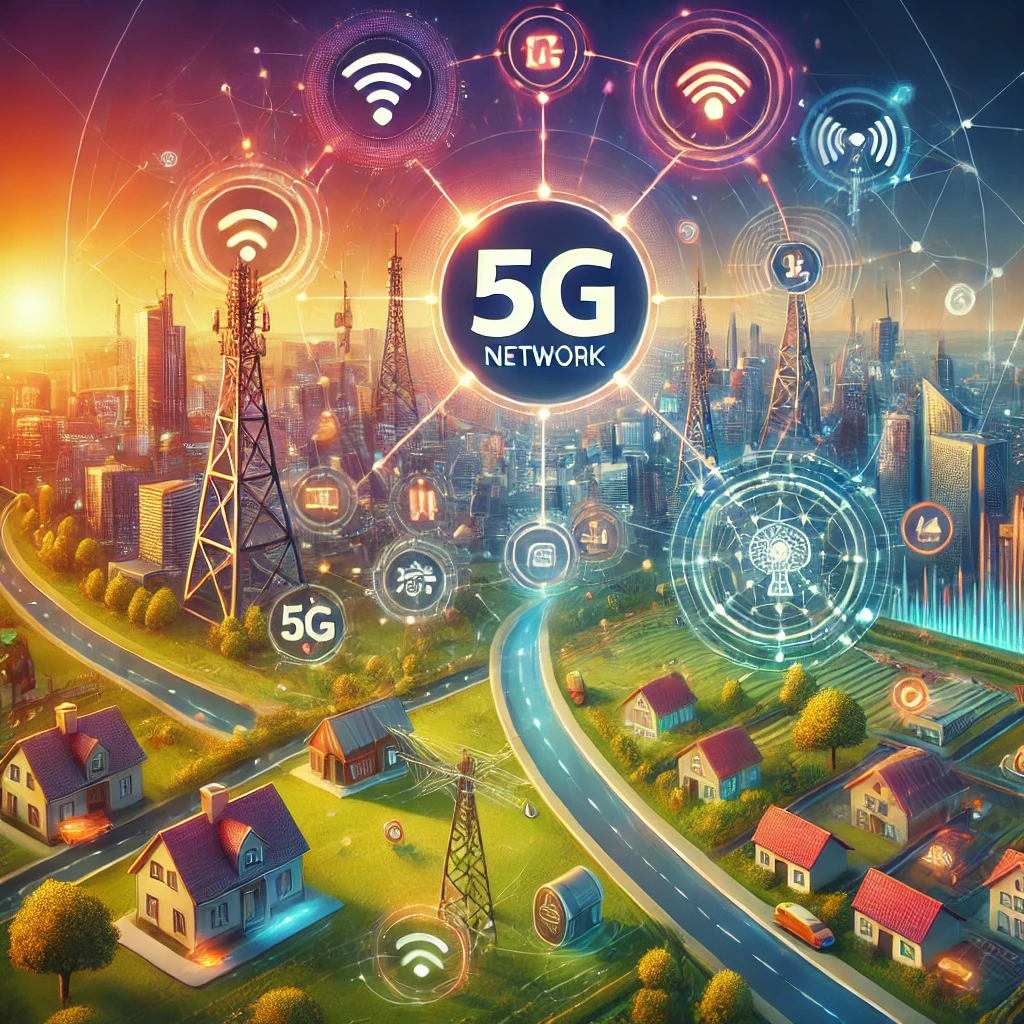Understanding the 5G Network Expansion: Deployment, Rollout, and Future Prospects
The rapid expansion of the 5G network has become a cornerstone of technological advancement, promising faster speeds, lower latency, and greater connectivity. As the world transitions from 4G to 5G, understanding the various aspects of this new technology is essential. In this comprehensive guide, we will delve into the 5G network expansion, including its deployment, rollout, coverage map, infrastructure, advancements, spectrum allocation, and the benefits and challenges it brings. Whether you’re interested in 5G in rural areas or curious about the leading network providers, this article has you covered.
The 5G Network Expansion: Deployment and Rollout
5G Deployment: The Beginning of a New Era
The deployment of the 5G network marks the beginning of a new era in telecommunications. Unlike previous generations, 5G deployment involves a more complex and layered approach, incorporating various frequency bands and technologies. Here’s how 5G deployment is shaping up:
- Phased Approach: The 5G network is being deployed in phases, starting with major urban centers and gradually expanding to suburban and rural areas.
- Frequency Bands: 5G utilizes multiple frequency bands, including low-band, mid-band, and high-band (millimeter wave) spectrums, each offering different coverage and performance characteristics.
- Infrastructure Requirements: The deployment of 5G requires significant investment in infrastructure, including new cell towers, small cells, and fiber-optic networks to support the increased data demands.
5G Rollout: From Urban Centers to Rural Areas
The rollout of the 5G network is a gradual process, with initial focus on densely populated urban areas. However, expanding 5G to rural areas is equally important to ensure nationwide connectivity. Key points of the 5G rollout include:
- Urban Focus: Major cities and metropolitan areas are the primary targets for the initial 5G rollout due to higher population density and greater demand for high-speed connectivity.
- Rural Expansion: Efforts are underway to extend 5G coverage to rural areas, addressing the digital divide and ensuring that remote communities benefit from the latest technology.
- Timeline: The complete rollout of 5G is expected to take several years, with ongoing upgrades and expansions to improve coverage and performance.
Mapping 5G Coverage and Building Infrastructure: Reaching Urban and Rural Areas
5G Coverage Map: Visualizing Network Reach
A 5G coverage map is an essential tool for visualizing the reach of the 5G network. These maps provide valuable insights into where 5G is currently available and where it is expected to expand. Key features of a 5G coverage map include:
- Current Coverage: Displays areas where 5G service is already available, typically in major cities and urban centers.
- Future Expansions: Highlights planned expansions and areas where 5G coverage will be rolled out next.
- Network Providers: Shows which network providers offer 5G service in specific regions, allowing users to compare coverage and performance.
Building 5G Infrastructure: The Backbone of Connectivity
The success of the 5G network depends on robust infrastructure that can support increased data traffic and provide seamless connectivity. Building this infrastructure involves several critical components:
- Small Cells: Small cell technology is vital for 5G, allowing for increased network density and improved coverage, especially in urban areas.
- Fiber Optics: Fiber-optic networks are the backbone of 5G, providing the necessary bandwidth and speed for high-capacity data transfer.
- Edge Computing: Implementing edge computing solutions helps reduce latency by processing data closer to the source, enhancing the performance of 5G applications.
5G in Rural Areas: Bridging the Digital Divide
Expanding the 5G network to rural areas is crucial for ensuring equitable access to high-speed internet and digital services. Here’s how 5G is making a difference in rural communities:
- Enhanced Connectivity: 5G provides faster internet speeds and more reliable connections, improving access to online education, healthcare, and business opportunities.
- Economic Growth: Improved connectivity can drive economic growth in rural areas by attracting new businesses and enabling local enterprises to expand their reach.
- Infrastructure Challenges: Deploying 5G in rural areas presents unique challenges, including the need for extensive infrastructure investments and overcoming geographical obstacles.
Advancements in 5G Technology: Spectrum Allocation and Key Network Providers
5G Technology Advancements: Pushing Boundaries
The advancements in 5G technology are revolutionizing the way we connect and interact with the digital world. Key innovations driving 5G include:
- Massive MIMO: Multiple-input and multiple-output (MIMO) technology increases the capacity and efficiency of 5G networks by using multiple antennas to transmit and receive data simultaneously.
- Beamforming: Beamforming technology directs signals towards specific users, improving signal strength and reducing interference.
- Network Slicing: This allows the creation of virtual networks tailored to specific applications or services, optimizing performance and resource allocation.
5G Spectrum Allocation: Managing Frequency Bands
Spectrum allocation is a critical aspect of the 5G network, determining how different frequency bands are utilized. Key considerations in 5G spectrum allocation include:
- Low-Band Spectrum: Offers extensive coverage and better penetration through buildings, making it ideal for rural areas.
- Mid-Band Spectrum: Balances coverage and capacity, providing faster speeds and supporting a wide range of applications.
- High-Band Spectrum: Delivers ultra-fast speeds and low latency, suitable for densely populated urban areas and advanced applications like virtual reality and autonomous vehicles.
5G Network Providers: Leading the Charge
Several major network providers are leading the charge in the 5G network expansion. These providers are investing heavily in infrastructure and technology to deliver comprehensive 5G coverage. Leading 5G network providers include:
- Verizon: Known for its extensive 5G Ultra Wideband network, offering high-speed connectivity in major cities.
- AT&T: Provides nationwide 5G coverage with a focus on both urban and rural areas.
- T-Mobile: Combines low-band, mid-band, and high-band spectrum to offer wide-reaching 5G service across the country.
Weighing the Benefits and Challenges of 5G Network Expansion
Benefits of 5G Network
The benefits of the 5G network are transformative, impacting various aspects of our daily lives and industries. Key benefits include:
- Faster Speeds: 5G offers significantly faster download and upload speeds compared to 4G, enabling seamless streaming, gaming, and data transfer.
- Lower Latency: Reduced latency enhances real-time applications like online gaming, virtual reality, and remote surgery.
- Increased Capacity: 5G can support a larger number of connected devices, driving the growth of the Internet of Things (IoT) and smart cities.
Challenges of 5G Network Expansion
Despite its numerous benefits, the expansion of the 5G network also presents several challenges:
- Infrastructure Costs: Building the necessary infrastructure for 5G is expensive and time-consuming, requiring significant investments from network providers.
- Regulatory Hurdles: Navigating regulatory requirements and securing spectrum licenses can be complex and vary by region.
- Environmental Concerns: The deployment of new cell towers and equipment raises environmental and aesthetic concerns in some communities.
Addressing the Challenges
To address these challenges, collaboration between government, industry, and communities is essential. Strategies include:
- Public-Private Partnerships: Collaborating on infrastructure projects can reduce costs and expedite deployment.
- Regulatory Support: Streamlining regulatory processes and providing incentives can facilitate faster 5G expansion.
- Community Engagement: Engaging with local communities to address concerns and demonstrate the benefits of 5G can foster acceptance and support.
The expansion of the 5G network is a monumental step forward in the evolution of telecommunications. From deployment and rollout to advancements in technology and the benefits and challenges it presents, understanding the intricacies of 5G is crucial. As 5G continues to expand, both urban and rural areas will experience the transformative impact of faster speeds, lower latency, and increased connectivity.
By leveraging the latest advancements and addressing the challenges head-on, the 5G network will play a pivotal role in shaping the future of communication and technology. For more insights into the world of technology and education, visit Regent Studies. To stay updated on the latest developments in 5G and other technological advancements, check out this external resource. The journey of the 5G network is just beginning, and its potential to revolutionize our lives is boundless.




